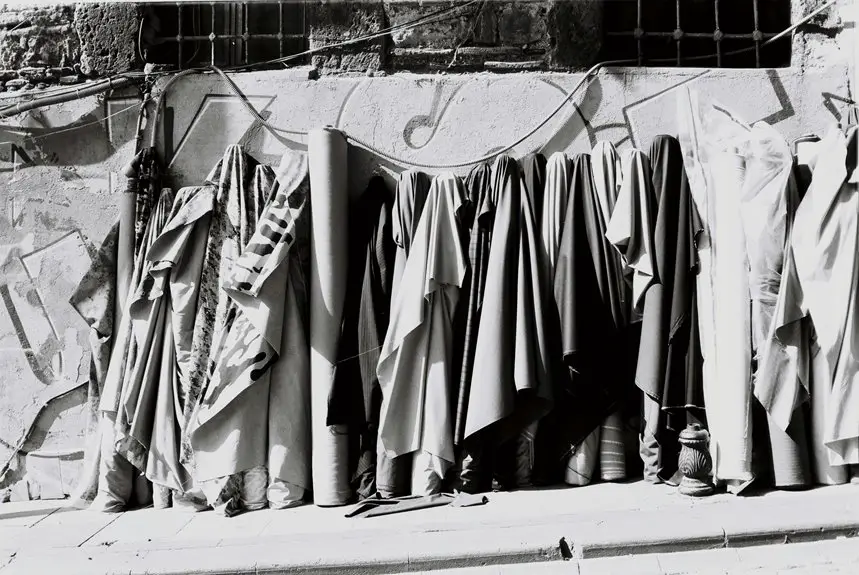Mulberry silk fabric comes from silkworms that feed exclusively on mulberry leaves, giving it a smooth, luxurious feel that’s soft against your skin. This silk is durable yet delicate, with a natural sheen and lightweight drape, making it perfect for clothing or home textiles. It’s hypoallergenic and moisture-wicking for comfort. As you explore further, you’ll discover its rich history, production process, and how to care for this elegant, eco-friendly fabric.
Table of Contents
Key Takeaways
- Mulberry silk is a luxurious fabric made from silkworms fed exclusively on mulberry leaves, ensuring smooth, strong fibers and a lustrous finish.
- Originating in ancient China around 2700 BCE, Mulberry silk symbolizes status and was historically reserved for royalty and elites.
- The production involves carefully rearing silkworms, harvesting cocoons at the right time, and extracting silk threads by soaking in hot water.
- Mulberry silk is naturally hypoallergenic, lightweight, moisture-wicking, and ideal for sensitive skin, commonly used in clothing, bedding, and home decor.
- Caring for Mulberry silk requires gentle hand washing, avoiding sunlight, low-heat ironing, and proper storage; it is biodegradable but resource-intensive to produce.
The Origin of Mulberry Silk
Although mulberry silk has become a symbol of luxury today, its origins trace back thousands of years to ancient China. You might be surprised to learn that this fine fabric was first cultivated around 2700 BCE.
Mulberry silk’s luxurious legacy began in ancient China around 2700 BCE, weaving history into every thread.
Legend credits Empress Leizu with discovering silk when a cocoon fell into her tea, unraveling its delicate thread. From there, sericulture—the art of raising silkworms—flourished, making silk a prized commodity.
You’d find it reserved for royalty and high officials, symbolizing status and elegance. Over centuries, silk spread along the Silk Road, connecting East and West.
When you wear mulberry silk now, you’re embracing a rich heritage shaped by innovation and tradition. It’s more than fabric; it’s a story woven through history.
How Mulberry Silk Is Produced
You’ll first learn how silkworms are carefully raised to guarantee high-quality silk.
Then, you’ll see the techniques used to harvest their cocoons without damaging the fibers.
Finally, you’ll discover how the delicate silk threads are extracted to create luxurious fabric.
Silkworm Rearing Process
When you watch a silkworm spin its cocoon, you’re witnessing the start of the mulberry silk production process.
To rear these silkworms, you first provide them with fresh mulberry leaves, their exclusive diet, which is essential for healthy growth. You’ll keep them in a clean, controlled environment to maintain ideal temperature and humidity.
Over about 25-30 days, the larvae go through several molting stages, growing rapidly. During this time, you’ll regularly supply fresh leaves and remove waste to prevent disease.
Once fully grown, the silkworms begin spinning their cocoons by secreting a continuous silk thread. Your careful attention during this rearing phase guarantees the silk’s quality and strength, setting the foundation for premium mulberry silk fabric.
Cocoon Harvesting Techniques
Several careful steps go into harvesting silkworm cocoons to produce high-quality mulberry silk.
First, you monitor the silkworms closely until they spin their cocoons fully, which usually takes about 2-3 days. Timing is vital; harvesting too early or late affects silk quality.
Once the cocoons are ready, you gently collect them by hand or use mechanical means, guaranteeing you don’t damage the delicate filaments.
After collection, you sort the cocoons by size and quality to maintain consistency.
Finally, you clean the cocoons by removing any debris or dead pupae to prepare them for the next stage.
Silk Thread Extraction
Although harvesting cocoons marks an essential step, the true transformation begins during silk thread extraction.
You start by soaking the cocoons in hot water to soften the sericin, the natural gum holding the fibers together. This process makes it easier to unwind the long silk filaments.
Next, you carefully find the thread’s end and gently pull it, unrolling continuous strands that can be up to several hundred meters long. These strands are then combined to form a single thread strong enough for weaving.
Throughout this process, maintaining the right temperature and timing is vital to preserve the silk’s quality.
Characteristics of Mulberry Silk Fabric
You’ll notice Mulberry silk feels incredibly smooth and luxurious against your skin.
It’s also surprisingly durable, but you’ll need to handle it with care to maintain its beauty.
Let’s explore what makes its texture unique and how to keep it looking great.
Texture and Feel
Silk’s natural sheen and smoothness make Mulberry silk fabric stand out from other textiles. When you touch it, you’ll notice its incredibly soft, almost buttery feel against your skin.
The fabric glides effortlessly, thanks to the long, fine fibers produced by silkworms fed exclusively on mulberry leaves. This creates a surface that feels cool and luxurious, even on warm days.
Unlike rougher fabrics, Mulberry silk doesn’t irritate or cling, making it perfect for sensitive skin. You’ll also find it lightweight yet substantial, offering a delicate drape that enhances garments and bedding alike.
Once you experience Mulberry silk’s unique texture, you’ll understand why it remains a top choice for those seeking comfort combined with elegance.
Durability and Care
Mulberry silk fabric offers impressive durability when you handle it with care. Though strong, it’s still delicate compared to synthetic fabrics, so treating it gently extends its life.
To keep your silk looking pristine, follow these guidelines:
- Avoid exposure to direct sunlight for long periods to prevent fading and weakening.
- Hand wash with mild detergent in cold water; never wring or twist the fabric.
- Store in a cool, dry place away from rough surfaces to prevent snags and tears.
Differences Between Mulberry Silk and Other Silks
Although all silks share a luxurious feel, they differ considerably in origin, texture, and durability.
Mulberry silk comes from silkworms fed exclusively on mulberry leaves, resulting in a smoother, stronger fiber compared to wild silks like Tussar or Eri.
Mulberry silk’s exclusive mulberry leaf diet creates fibers smoother and stronger than those of wild silks.
You’ll notice Mulberry silk’s uniform texture and lustrous shine, while other silks often have a coarser feel and matte finish due to their varied diets and environments.
Additionally, Mulberry silk fibers are longer, enhancing strength and sheen, whereas wild silks have shorter fibers, making them less durable.
Benefits of Using Mulberry Silk
When you choose silk for your clothing or bedding, you want a fabric that combines luxury with practical benefits. Mulberry silk delivers on both fronts, making it a standout choice.
This silk is incredibly soft and smooth, giving you a gentle touch against your skin. It’s also naturally hypoallergenic, which helps reduce irritation and keeps allergens at bay. Plus, its moisture-wicking properties keep you comfortable by regulating temperature.
Here are a few key benefits you’ll enjoy with Mulberry silk:
- Durability: Strong fibers mean your silk items last longer.
- Breathability: Keeps you cool in summer and warm in winter.
- Natural sheen: Offers a subtle, elegant shine without needing treatments.
Choosing Mulberry silk means investing in comfort and quality.
Common Uses for Mulberry Silk Fabric
You’ll find Mulberry silk in a variety of items, from luxurious clothing and apparel to soft bedding and linens.
It also makes beautiful accessories and elegant home decor.
Let’s explore how this fabric enhances each of these uses.
Clothing and Apparel
Mulberry silk’s smooth texture and natural sheen make it a favorite choice for clothing and apparel. When you wear garments made from this luxurious fabric, you notice its lightweight feel and breathability instantly. It’s perfect for those who want comfort without sacrificing elegance.
You’ll find mulberry silk commonly used in:
- Blouses and shirts: Offering a sleek, polished look for both casual and formal settings.
- Dresses and evening gowns: Enhancing your outfit with a subtle shimmer and fluid drape.
- Lingerie and sleepwear: Providing softness and a gentle touch against your skin.
Choosing mulberry silk clothing means you get durability and hypoallergenic benefits too, making it a smart and stylish addition to your wardrobe.
Bedding and Linens
Beyond clothing, silk’s luxurious qualities extend beautifully into bedding and linens. When you choose Mulberry silk sheets or pillowcases, you’re opting for softness that feels gentle on your skin, reducing irritation and keeping your complexion smooth.
The fabric’s natural temperature-regulating properties help you stay cool in summer and warm in winter, enhancing your sleep quality. Plus, silk’s hypoallergenic nature resists dust mites and allergens, making it ideal if you have sensitive skin or allergies.
Mulberry silk bedding also adds a subtle sheen and elegance to your bedroom, instantly elevating the space. Whether you’re investing in a complete silk sheet set or just pillow covers, you’ll experience comfort and luxury every night without sacrificing practicality or durability.
Accessories and Decor
Silk accessories and decor bring a touch of elegance and sophistication to any space or outfit. When you choose Mulberry silk, you’re opting for a luxurious texture and natural sheen that instantly elevates your style or home ambiance.
You can easily incorporate this fabric into your daily life with:
- Decorative throw pillows that add softness and shine to your living room.
- Elegant scarves or ties that complement your wardrobe with a subtle, refined glow.
- Drapes or curtains that create a light, flowing atmosphere while providing a smooth finish.
Using Mulberry silk in these ways not only highlights its durability and smoothness but also lets you enjoy its natural hypoallergenic qualities.
It’s a simple upgrade that makes a big impact.
How to Identify Genuine Mulberry Silk
Although it can be tricky at first, you’ll quickly learn to spot genuine Mulberry silk by examining its texture, sheen, and weight.
Real Mulberry silk feels smooth and soft against your skin, with a natural, subtle sheen that isn’t overly shiny or plastic-like. It’s lightweight but has a noticeable density compared to synthetic fabrics.
Real Mulberry silk is smooth, softly lustrous, lightweight, yet denser than synthetic fabrics.
When you gently pinch the fabric, it should feel cool initially and warm up quickly. Look closely at the weave—true Mulberry silk has a tight, uniform weave without loose threads or fuzziness.
Also, genuine silk doesn’t wrinkle easily; it springs back after being scrunched. If you can, do a simple burn test on a small, hidden thread—it smells like burnt hair and leaves ash, unlike plastic synthetics.
These clues help you confidently choose authentic Mulberry silk.
Caring for Mulberry Silk Products
Caring for Mulberry silk products requires gentle handling to maintain their luxurious feel and durability. You’ll want to treat them with care to preserve their natural luster and strength.
Here’s how you can keep your silk items in top shape:
- Hand wash with cold water: Use a mild detergent designed for delicate fabrics to avoid damaging the fibers.
- Avoid direct sunlight: Dry your silk products in the shade to prevent fading and weakening of the fabric.
- Iron on low heat: If needed, iron on the silk setting or use a cloth between the iron and the fabric to prevent burns or shine.
Environmental Impact of Mulberry Silk Production
While producing mulberry silk offers a luxurious fabric, it also has environmental consequences you should consider. Growing mulberry trees requires land, water, and sometimes pesticides, which can impact local ecosystems. The silkworms feed exclusively on mulberry leaves, so large-scale cultivation is necessary.
However, mulberry trees are generally sustainable since they grow quickly and help prevent soil erosion. The process of harvesting silk can be resource-intensive, using significant energy and water, especially in the degumming and dyeing stages.
On the plus side, mulberry silk is biodegradable, reducing long-term waste compared to synthetic fibers. When you choose mulberry silk, look for producers who implement eco-friendly practices, like organic farming and water recycling, to minimize environmental harm while enjoying this elegant fabric.
Mulberry Silk in Fashion and Home Decor
Understanding the environmental impact of mulberry silk helps you appreciate the value of this fabric beyond its beauty.
When you choose mulberry silk, you’re embracing elegance and sustainability, making it a versatile choice for both fashion and home decor.
You’ll find mulberry silk in:
- Clothing: Luxurious dresses, blouses, and scarves that feel soft against your skin.
- Bedding: Smooth, breathable sheets and pillowcases that promote better sleep.
- Decor: Elegant curtains and cushion covers that add a touch of sophistication to your space.
Mulberry silk’s durability and natural sheen guarantee that these items not only look stunning but also last longer, making your investment worthwhile.
Incorporating mulberry silk into your lifestyle means enjoying comfort, style, and eco-consciousness all at once.
Price Factors Affecting Mulberry Silk Fabric
Several key factors influence the price of mulberry silk fabric, and knowing these can help you make smarter purchasing decisions.
First, the quality of the silk plays a major role—longer fibers from pure mulberry silkworms create smoother, stronger fabric, which costs more.
The fabric’s momme weight, which measures thickness, also affects price; higher momme means denser, more durable silk and a higher cost.
Additionally, the production process matters—handcrafted or organic silk commands a premium due to labor and sustainability.
Where the silk is sourced impacts price too; silk from top-producing regions like China or Japan tends to be pricier.
Finally, finished treatments or blends with other fibers can alter cost.
Understanding these factors guarantees you get value for your investment in mulberry silk.
Tips for Buying Quality Mulberry Silk
When you shop for mulberry silk, knowing what to look for can save you from costly mistakes. Quality silk feels smooth, lightweight, and has a natural sheen without appearing glossy.
To guarantee you get the best, focus on these tips:
- Check the momme weight: A higher momme (between 19-25) means denser, more durable silk.
- Look for certifications: OEKO-TEX or similar labels guarantee chemical-free, safe fabric.
- Inspect the weave: Tight, even weaving guarantees longevity and prevents snagging.
Avoid silk that feels rough or looks dull, as it might be blended or low grade.
Also, trust reputable sellers who provide clear fabric details.
These steps will help you confidently pick premium mulberry silk that lasts and feels luxurious.
Frequently Asked Questions
Can Mulberry Silk Cause Allergies or Skin Irritation?
You generally won’t experience allergies or skin irritation from mulberry silk since it’s hypoallergenic and smooth. However, if you’re sensitive to proteins or have specific allergies, it’s best to test a small patch first.
Is Mulberry Silk Suitable for People With Sensitive Skin?
You’ll find mulberry silk great for sensitive skin since it’s hypoallergenic, smooth, and breathable. It reduces irritation and won’t trap moisture or bacteria, helping your skin stay calm and comfortable throughout the day.
How Does Mulberry Silk Compare to Synthetic Silk in Durability?
They say, “Good things come to those who wait.” Mulberry silk outlasts synthetic silk, offering superior durability and strength. You’ll find it resists wear better, making it a smarter, longer-lasting choice for your wardrobe.
Can Mulberry Silk Fabric Be Dyed Easily at Home?
You can dye mulberry silk at home, but it requires gentle handling and specific dyes for protein fibers. Use acid dyes, avoid high heat, and test a small piece first to guarantee vibrant, even color results.
What Are the Best Storage Methods for Mulberry Silk Garments?
Sure, just toss your mulberry silk garments in the nearest sweaty gym bag—kidding! You should store them in a cool, dry place, preferably in breathable cotton bags to avoid moisture and pesky moth attacks.
- The Use of Nonwovens in Construction and Civil Engineering - July 11, 2025
- The Use of Nonwovens in Construction and Civil Engineering - July 11, 2025
- The Use of Nonwovens in Construction and Civil Engineering - July 11, 2025







